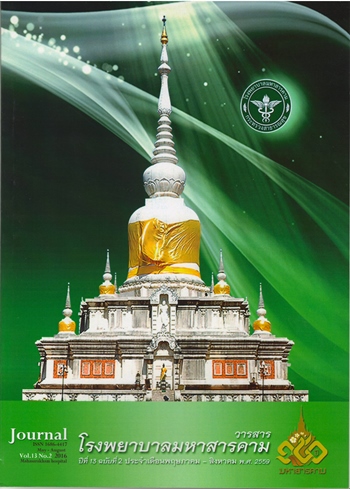การศึกษาระบาดวิทยาผู้ป่วยเด็กสมองพิการ ในโรงพยาบาลสรรพสิทธิประสงค์ จังหวัดอุบลราชธานี
บทคัดย่อ
วัตถุประสงค์ : เพื่อศึกษาระบาดวิทยาของผู้ป่วยเด็กสมองพิการที่มารับการรักษาที่แผนกผู้ป่วยนอก กลุ่มงานเวชกรรม ฟื้นฟู โรงพยาบาลสรรพสิทธิประสงค์เพื่อนำข้อมูลไปสู่การพัฒนาการบริการและงานวิจัย
รูปแบบการวิจัย : การศึกษาเชิงพรรณนาแบบเก็บข้อมูลย้อนหลัง
สถานที่ทำการวิจัย : แผนกผู้ป่วยนอก กลุ่มงานเวชกรรมฟื้นฟู โรงพยาบาลสรรพสิทธิประสงค์
กลุ่มประชากร : ผู้ป่วยเด็กสมองพิการที่มารับบริการที่คลินิกผู้ป่วยโรคสมองพิการ แผนกผู้ป่วยนอก กลุ่มงานเวชกรรม ฟื้นฟู โรงพยาบาลสรรพสิทธิประสงค์ ตั้งแต่เดือนมกราคม 2553 – ธันวาคม 2558
วิธีการศึกษา : สืบค้นข้อมูลย้อนหลังจากแฟ้มเอกสารเฉพาะของผู้ป่วยโรคสมองพิการ
ผลการศึกษา : ผู้ป่วยทั้งหมด 297 ราย มีรายงานบันทึกในแฟ้มข้อมูลเด็กสมองพิการ 246 รายเป็นหญิง 107 ราย คิดเป็นร้อยละ 43.5 และชาย 139 รายคิดเป็นร้อยละ 56.5 ช่วงอายุที่พบบ่อยได้แก่ อายุ 3-6 ปีคิดเป็นร้อยละ 42.7 การแบ่ง ประเภทของสมองพิการพบประเภทเกร็ง (Spastic)มากทีสุดร้อยละ 92.7 โดยพบว่าเกร็งขามากกว่าแขนร้อยละ 40.7 เกร็ง ทั้งตัวร้อยละ 32.5 เกร็งครึ่งซีกร้อยละ 18.3 แขนหรือขาข้างเดียวร้อยละ 1.2 และ Athetoid ร้อยละ 7.3 การแบ่งระดับ ความรุนแรงตามระบบ GMFCS E&R พบระดับ 1,2,3, 4, 5 ร้อยละ 7.7, 22.8, 32.9, 20.3 และ 16 ตามลำดับ ปัจจัยเสี่ยง ต่อภาวะสมองพิการได้แก่ น้ำหนักตัวแรกคลอดต่ำกว่ากำหนดร้อยละ 24.19 คลอดก่อนกำหนดร้อยละ 23.8 ขาดออกซิเจน ตอนคลอดร้อยละ 8.7 ปัญหาร่วมพบเกร็ง (Spastic)ร้อยละ 84.1 การพูดร้อยละ 59.3 ทุพโภชนาการร้อยละ 38.6 น้ำลาย ยืดร้อยละ 35.7 การับรู้ร้อยละ 28ปากและฟันร้อยละ 21.5 การขับถ่ายร้อยละ 21.1 และตาเขร้อยละ 16.7ภาวะแทรกซ้อน ที่พบได้แก่ข้อยึดติดร้อยละ 18.3 ข้อสะโพกเคลื่อนหรือหลุดร้อยละ 2.4 และหลังคดร้อยละ 2
สรุป : ผู้ป่วยเด็กสมองพิการที่มารับบริการที่คลินิกผู้ป่วยโรคสมองพิการ แผนกผู้ป่วยนอก กลุ่มงานเวชกรรมฟื้นฟู โรง พยาบาลสรรพสิทธิประสงค์ ตั้งแต่เดือนมกราคม 2553 – ธันวาคม 2558 ปัญหาเกร็ง (Spastic) เป็นปัญหาที่พบมากที่สุด ตามด้วยการพูดและภาวะทุพโภชนาการ ภาวะแทรกซ้อนที่พบมากที่สุดได้แก่ ข้อยึดติด
คำสำคัญ : เด็กสมองพิการ,ภาวะเกร็ง,GMFCS E&R
เอกสารอ้างอิง
Johnson null. Cerebral palsies: epidemiology and causal pathways. Archives of Disease in Childhood. 2000 ;83(3):279A.
Pruitt DW, Tsai T. Common medical comorbidities associated with cerebral palsy. Physical Medicine and Rehabilitation Clinics of North America. 2009 ;20(3):453–67.
Surveillance of Cerebral Palsy in Europe.Surveillance of cerebral palsy in Europe: a collaboration of cerebral palsy surveys and registers. Surveillance of Cerebral Palsy
in Europe (SCPE). Developmental Medicine&Child Neurology. 2000 ;42(12):8–24.
Pruitt DW, Tsai T. Common medical comorbidities associated with cerebral palsy. Physical Medicine and Rehabilitation Clinics of North America. 2009 ;20(3):453–67.
Ziv I, Blackburn N, Rang M, Koreska J. Muscle growth in normal and spastic mice. Developmental Medicine&Child Neurology. ;26(1):94–9.
Reid SM, Carlin JB, Reddihough DS. Distribution of motor types in cerebral palsy: how do registry data compare?. DevelopmentalMedicine&Child Neurology. 2011 ;53(3):–8.
Reid SM, Carlin JB, Reddihough DS. Classification of topographical pattern of spasticity in cerebral palsy: a registry perspective. Research in Developmental Disability.2011
;32(6):2909–15.
Alliance CP. Gross Motor Function Classification System (GMFCS) | Cerebral Palsy Alliance. [cited 2016 Apr 20]. Available from: https://www.cerebralpalsy.org.au/what-is-cerebralpalsy/severity-of-cerebral-palsy/grossmotor-function-classification-system/
Palisano R, Rosenbaum P, Walter S, Russell D,Wood E, Galuppi B. Development and reliability of a system to classify gross motor function in children with cerebral palsy. Developmental Medicine& Child Neurology. 1997 ;39(4):214–23.
ศิรินาถ เลียบศิรินนท์, พินัยลัค ตันติลีปิกร, น้ำฝนมหาทรัพย์. GMFCS © 1977 ฉบับภาษาไทย. วารสารกายภาพบำบัด2551;30(1):26-36.
Palisano R, Rosenbaum P, Bartlett D, Livingston M, GMFCS E&R ©2007.[cited 2013 Jan 10].Available from: https://www.cpqcc.org/sites/ default/files/documents/HRIF_QCI_Docs/GMFCS-ER.pdf
วัณทนา ศิริธราธิวัตร, Ian Thomas, GMFCS E&R Thai Translation.[cited 2013 Jan 10]. Available from : https://canchild.ca/system/tenon/assets/attachments/ 000/000/081/original/ GMFCS-ER_Translation-Thai.pdf
Wood E, Rosenbaum P. The gross motor function classification system for cerebral palsy: a study of reliability and stability over time. Developmental Medicine&Child
Neurology. 2000 ;42(5):292–6.
Cooley WC, American Academy of Pediatrics Committee on Children With Disabilities. Providing a primary care medical home for children and youth with cerebral palsy. Pediatrics. ;114(4):1106–13.
Pellegrino L. Cerebral palsy. In: Batshaw ML,Pellegrino L, Roizen NJ, editors. Children with disabilities. 6th edition. Baltimore (MD):Paul H. Brookes Publishing Co. 2007; p.387-408
Cooley WC, American Academy of Pediatrics Committee on Children With Disabilities.Providing a primary care medical home for children and youth with cerebral
palsy. Pediatrics. 2004 ;114(4):1106–13.
Pongurgsorn C, Tosayanonda O. Clinical study in cerebral palsy. Journal of Thai Rehabilitation Medicine. 1992;2:14-9.
Dahl M, Thommessen M, Rasmussen M, Selberg T. Feeding and nutritional characteristics in children with moderate or severe cerebral palsy. Acta Paediatrica. 1996
;85(6):697–701.
นันท์ชญาน์ ฉายะโอกาส, ศรีนวล ชวศิริม กมลทิพย์ หาญผดุงกิจ. ความชุกของภาวะทุพโภชนาการในผู้ป่วยเด็กพิการสมองใหญ่ที่ภาควิชาเวชศาสตร์ฟื้นฟูโรงพยาบาลศิริราช. เวชศาสตร์ฟื้นฟูสาร;24(2):55-59
Belonwu RO, Gwarzo GD, Adeleke SI. Cerebral palsy in Kano, Nigeria--a review. Nigerian Journal of Medicine. 2009 ;18(2):186–9.
Terjesen T. The natural history of hip development in cerebral palsy. Developmental Medicine Child Neurology.;54(10):951–7.
พรชัย งามธนวัฒน์, ศรีนวล ชวศิริ. การศึกษาระบาดวิทยาในผู้ป่วยเด็กที่มารับการรักษาที่ภาควิชาเวชศาสตร์ฟื้นฟู คณะแพทยศาสตร์ศิริราชพยาบาล. เวชศาสตร์ฟื้นฟูสาร 2559;26(1):31-38
ดาวน์โหลด
เผยแพร่แล้ว
รูปแบบการอ้างอิง
ฉบับ
ประเภทบทความ
สัญญาอนุญาต
วารสารนี้เป็นลิขสิทธิ์ของโรงพยาบาลมหาสารคาม






